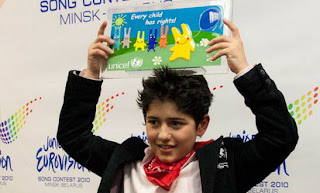On 3 December 2011, the Junior Eurovision Song Contest 2011 will be held in the Karen Demirchyan Sports and Concerts Complex , also known as Demirchyan Arena, Sports & Music Complex, SCC or simply Hamalir.
The SCC was put in commission in 1983. Later it was named after Karen Demirchyan. The projecting of the building was made by the «Armstateproject» and by the USSR National architect Korjun Akopyan, the ASSR National architect Arthur Tarhanyan, the ASSR Honoured architects Hrachya Pogosyan, Spartak Khachikyan, Gurgen Mushegyan, engineers Igor Tsaturyan, Grigor Azizyan, Mikael Aharonyan, sculptor Ferdinant Arakelyan in particular. In 1987 this group has been awarded the higher prize of the country – the State award of USSR for the original architecture and planning solutions.
The complex has a unique design, an outside view of the whole construction reminds the shape a big bird opening its wings. Its architectural concepts include a turning tribune seating 1200, which can rapidly connect the two big halls to reveal additional seating. The sports-concert complex is a wonderful architectural construction which is in the centre of park Tsitsernakaberd. SCC is an embodiment of human dream and imagination. Complex possibilities are diverse, and the quantity of given services grows every day.
According to the decision of the Armenian government the sport concert complex was sold to Russian company«BAMO». The company has invested more than 40 milion for the reconstruction, repair and equipment of the complex. Thanks to the repair works and reconstruction the complex was equipped and supplied with modern security, heating, ventilation, communication, audio and video systems. Today the SCC, reconstructed, completely repaired and equipped wth modern techniques offers various kinds of entertainment: concerts, shows, sport championships, scientific meetings, exhibitions, conferences and meetings.
Famous artists such as Michel Legrand, Demis Rusos, the «La Scala» theatre symphonic orchestra, Tomas Anders, Bonnie M and Jean Gillan have performed on the stage of SCC. Here were held the international Olympic Chess Games, the European championship of ushu, the Armenian basketball games, the international sports struggle, boxing, weightlifting, art gymnastics and acrobatics tournaments and championships.
P.S. thanks K. Khontyan for pictures



















































